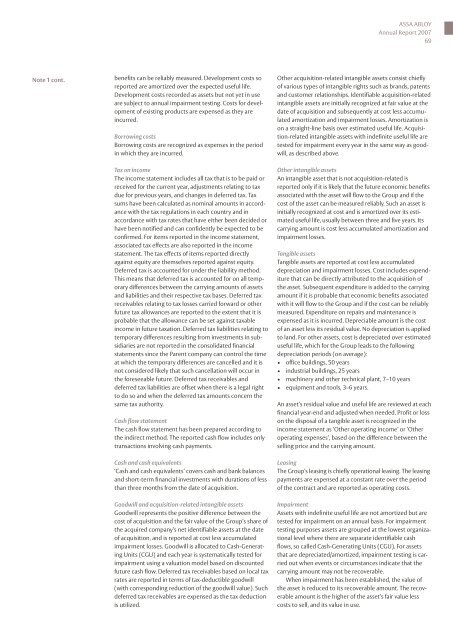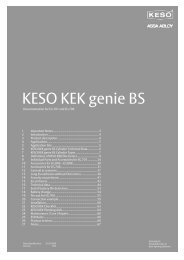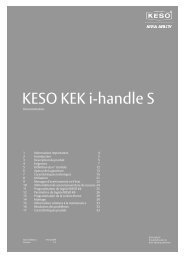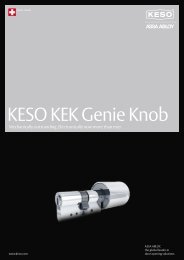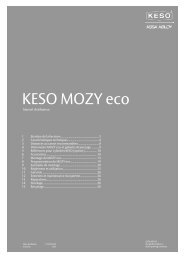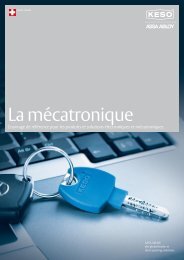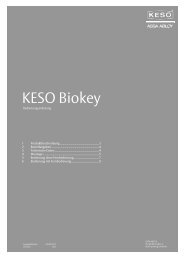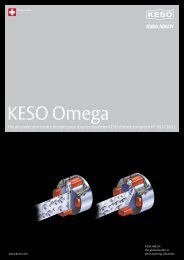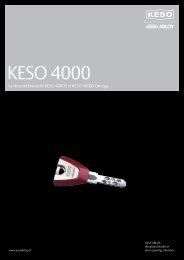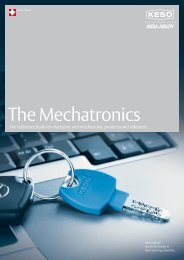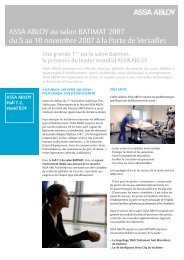You also want an ePaper? Increase the reach of your titles
YUMPU automatically turns print PDFs into web optimized ePapers that Google loves.
Note 1 cont.<br />
benefits can be reliably measured. Development costs so<br />
reported are amortized over the expected useful life.<br />
Development costs recorded as assets but not yet in use<br />
are subject to annual impairment testing. Costs for development<br />
of existing products are expensed as they are<br />
incurred.<br />
Borrowing costs<br />
Borrowing costs are recognized as expenses in the period<br />
in which they are incurred.<br />
Tax on income<br />
The income statement includes all tax that is to be paid or<br />
received for the current year, adjustments relating to tax<br />
due for previous years, and changes in deferred tax. Tax<br />
sums have been calculated as nominal amounts in accordance<br />
with the tax regulations in each country and in<br />
accordance with tax rates that have either been decided or<br />
have been notified and can confidently be expected to be<br />
confirmed. For items reported in the income statement,<br />
associated tax effects are also reported in the income<br />
statement. The tax effects of items reported directly<br />
against equity are themselves reported against equity.<br />
Deferred tax is accounted for under the liability method.<br />
This means that deferred tax is accounted for on all temporary<br />
differences between the carrying amounts of assets<br />
and liabilities and their respective tax bases. Deferred tax<br />
receivables relating to tax losses carried forward or other<br />
future tax allowances are reported to the extent that it is<br />
probable that the allowance can be set against taxable<br />
income in future taxation. Deferred tax liabilities relating to<br />
temporary differences resulting from investments in subsidiaries<br />
are not reported in the consolidated financial<br />
statements since the Parent company can control the time<br />
at which the temporary differences are cancelled and it is<br />
not considered likely that such cancellation will occur in<br />
the foreseeable future. Deferred tax receivables and<br />
deferred tax liabilities are offset when there is a legal right<br />
to do so and when the deferred tax amounts concern the<br />
same tax authority.<br />
Cash flow statement<br />
The cash flow statement has been prepared according to<br />
the indirect method. The reported cash flow includes only<br />
transactions involving cash payments.<br />
Cash and cash equivalents<br />
‘Cash and cash equivalents’ covers cash and bank balances<br />
and short-term financial investments with durations of less<br />
than three months from the date of acquisition.<br />
Goodwill and acquisition-related intangible assets<br />
Goodwill represents the positive difference between the<br />
cost of acquisition and the fair value of the Group’s share of<br />
the acquired company’s net identifiable assets at the date<br />
of acquisition, and is reported at cost less accumulated<br />
impairment losses. Goodwill is allocated to Cash-Generating<br />
Units (CGU) and each year is systematically tested for<br />
impairment using a valuation model based on discounted<br />
future cash flow. Deferred tax receivables based on local tax<br />
rates are reported in terms of tax-deductible goodwill<br />
(with corresponding reduction of the goodwill value). Such<br />
deferred tax receivables are expensed as the tax deduction<br />
is utilized.<br />
ASSA ABLOY<br />
Annual Report 2007<br />
69<br />
Other acquisition-related intangible assets consist chiefly<br />
of various types of intangible rights such as brands, patents<br />
and customer relationships. Identifiable acquisition-related<br />
intangible assets are initially recognized at fair value at the<br />
date of acquisition and subsequently at cost less accumulated<br />
amortization and impairment losses. Amortization is<br />
on a straight-line basis over estimated useful life. Acquisition-related<br />
intangible assets with indefinite useful life are<br />
tested for impairment every year in the same way as goodwill,<br />
as described above.<br />
Other intangible assets<br />
An intangible asset that is not acquisition-related is<br />
reported only if it is likely that the future economic benefits<br />
associated with the asset will flow to the Group and if the<br />
cost of the asset can be measured reliably. Such an asset is<br />
initially recognized at cost and is amortized over its estimated<br />
useful life, usually between three and five years. Its<br />
carrying amount is cost less accumulated amortization and<br />
impairment losses.<br />
Tangible assets<br />
Tangible assets are reported at cost less accumulated<br />
depreciation and impairment losses. Cost includes expenditure<br />
that can be directly attributed to the acquisition of<br />
the asset. Subsequent expenditure is added to the carrying<br />
amount if it is probable that economic benefits associated<br />
with it will flow to the Group and if the cost can be reliably<br />
measured. Expenditure on repairs and maintenance is<br />
expensed as it is incurred. Depreciable amount is the cost<br />
of an asset less its residual value. No depreciation is applied<br />
to land. For other assets, cost is depreciated over estimated<br />
useful life, which for the Group leads to the following<br />
depreciation periods (on average):<br />
• office buildings, 50 years<br />
• industrial buildings, 25 years<br />
• machinery and other technical plant, 7–10 years<br />
• equipment and tools, 3–6 years.<br />
An asset’s residual value and useful life are reviewed at each<br />
financial year-end and adjusted when needed. Profit or loss<br />
on the disposal of a tangible asset is recognized in the<br />
income statement as ‘Other operating income’ or ‘Other<br />
operating expenses’, based on the difference between the<br />
selling price and the carrying amount.<br />
Leasing<br />
The Group’s leasing is chiefly operational leasing. The leasing<br />
payments are expensed at a constant rate over the period<br />
of the contract and are reported as operating costs.<br />
Impairment<br />
Assets with indefinite useful life are not amortized but are<br />
tested for impairment on an annual basis. For impairment<br />
testing purposes assets are grouped at the lowest organizational<br />
level where there are separate identifiable cash<br />
flows, so called Cash-Generating Units (CGU). For assets<br />
that are depreciated/amortized, impairment testing is carried<br />
out when events or circumstances indicate that the<br />
carrying amount may not be recoverable.<br />
When impairment has been established, the value of<br />
the asset is reduced to its recoverable amount. The recoverable<br />
amount is the higher of the asset’s fair value less<br />
costs to sell, and its value in use.


